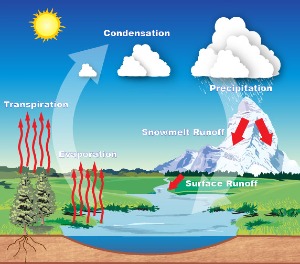
Many people wonder what the term is for when water travels from a glacier to the ocean to a cloud. There is one simple answer: the water cycle.
The water cycle is the path that all water follows as it moves around Earth. Liquid, solid, and gas are the three states of water. The oceans, rivers, lakes, streams, and other types of bodies contain liquid water. Water is also underneath the Earth’s surface. The three states are essentially the same, the only difference is the form.
Another wonder is how gas turns into a liquid, which then becomes a solid. There are key terms for these processes: evaporation, precipitation, and condensation. Evaporation occurs when the sun’s heat hits the water, causing it to become water vapor. This is how clouds are formed. Going along with this process is precipitation, which happens when sleet, rain, snow, or hail fall from a cloud. Lastly is condensation, which is the process of water vapor turning back to liquid water.
The water cycle will always continue to evaporate, precipitate, and condense. NASA currently has several missions concerning the water cycle. The Soil Moisture Active Passive satellite (SMAP), measures the amount of water in the top two inches of Earth’s soil. The satellite will help scientists understand the dynamic between severe drought conditions and water in the soil.
Understanding the water cycle and its importance is imperative for humans. Organizations such as NASA will bring more awareness on the cycle and how citizens can make sure it is protected.
[Source:
ClimateKids.Nasa.Gov
]

